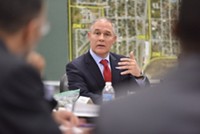Advertisement
Grab your lab coat. Let's get started
Welcome!
Welcome!
Create an account below to get 6 C&EN articles per month, receive newsletters and more - all free.
It seems this is your first time logging in online. Please enter the following information to continue.
As an ACS member you automatically get access to this site. All we need is few more details to create your reading experience.
Not you? Sign in with a different account.
Not you? Sign in with a different account.
ERROR 1
ERROR 1
ERROR 2
ERROR 2
ERROR 2
ERROR 2
ERROR 2
Password and Confirm password must match.
If you have an ACS member number, please enter it here so we can link this account to your membership. (optional)
ERROR 2
ACS values your privacy. By submitting your information, you are gaining access to C&EN and subscribing to our weekly newsletter. We use the information you provide to make your reading experience better, and we will never sell your data to third party members.
Policy
Regulatory Overlord
Obama’s pick for White House job endorses strict analysis of federal rules
by Cheryl Hogue
February 16, 2009
| A version of this story appeared in
Volume 87, Issue 7

THE MAN President Barack Obama has selected to oversee federal regulations in the White House Office of Management & Budget (OMB) defies classic political categorization. Is Cass R. Sunstein a liberal who embraces more federal regulation or a conservative who sets high hurdles for new health, safety, and environmental rules?
Sunstein might be both.
“He’s taken very liberal positions on some issues and what I consider to be conservative ones on others,” says Rick Melberth, director of federal regulatory policy at the watchdog group OMB Watch.
“You can’t really categorize the guy,” says Frank Maisano, an energy specialist at the Washington, D.C., law firm Bracewell & Giuliani. Maisano, who represents utilities, wind developers, and refiners, calls Sunstein a rationalist. He also describes him as an analyst who will look at all impacts of a regulation and determine whether the action is appropriate, with a solid justification backing up his decision.
If confirmed by the Senate, Sunstein, currently a professor at Harvard Law School, will head a little-known White House office that examines each pending federal regulation and either allows it to proceed, rejects it outright, or instructs an agency to redraft it. Rules dear to the chemical enterprise that affect pollution controls, chemical manufacturing, consumer product safety, drug approval, and workplace health issues all must pass the muster of the Office of Information & Regulatory Affairs, which is part of OMB.
Overall, businesses are greeting Sunstein’s nomination warmly. For instance, the American Chemistry Council (ACC), a main lobbying arm of the chemical industry, gives him positive marks.
“He is a preeminent legal scholar who has written extensively and thoughtfully on the issues of cost-benefit analysis and how to improve regulations to make them more efficient and effective,” according to an ACC statement. “His leadership in these areas will be critically important within the Obama Administration.”
Sunstein is well-known in academic and think-tank circles that focus on regulatory issues. He comes with heavyweight credentials: He earned his undergraduate and law degrees at Harvard University and was a law clerk for the late U.S. Supreme Court Justice Thurgood Marshall. For 27 years, Sunstein was a professor at the University of Chicago Law School, where he met Obama. In 2008, he became a law professor at Harvard, directing its Program on Risk Regulation. Harvard describes the program as focused on how law and policy deal with hazards, including climate change, occupational safety, and terrorism. Meanwhile, Sunstein’s name has been batted around as a possible nominee for the U.S. Supreme Court.
Like most presidential appointees who have not yet been confirmed to their jobs, Sunstein isn’t giving interviews. But he is a prolific writer and the author of several books that provide insight into his views on government regulations.
Sunstein is clearly a foe of the precautionary principle, the notion that regulators should protect the public against potential harms, such as exposure to toxic chemicals, even when the links between cause and effect aren’t clearly demonstrated. He attacks this regulatory approach in his book “Laws of Fear: Beyond the Precautionary Principle ,” published in 2005. Noting that the European Union embraces the precautionary principle, Sunstein says the differences in regulatory approaches on either side of the Atlantic arise because “Europeans favor precautions, whereas Americans seem to require something akin to proof of danger.”
Meanwhile, to the dismay of some progressive groups and to the delight of many businesses, Sunstein has strongly endorsed scrutiny of regulatory proposals with detailed analyses that calculate and compare their costs versus their benefits.
“Cost-benefit analysis is an exceedingly helpful tool, simply because it provides an understanding of the stakes—of what is to be gained and what is to be lost from regulatory interventions. If an environmental regulation would cost a great deal and do little to improve public health or the environment, there is no reason to adopt it,” Sunstein says in “Laws of Fear.” Nonetheless, he adds, this type of analysis “may neglect dangers that cannot be established with certainty.”
Notwithstanding this caveat, Sunstein’s critics are wary of his deep faith in this analytical tool. “Cost-benefit analysis is neither sound in theory nor useful in practice,” the Center for Progressive Reform, a left-leaning think tank, argues in a January report analyzing Sunstein’s writings. This tool “applies a patina of mathematical precision to an inherently distorted process” because it “relies on overstated cost estimates” for a regulation, while benefits tend to be underestimated, the report says.
Sunstein once posited that the Environmental Protection Agency should consider costs as it sets standards for how clean the air should be, points out Frank O’Donnell, president of nonprofit group Clean Air Watch. Industry argued that costs should be included in these EPA regulations all the way to the Supreme Court as part of a challenge to EPA’s 1997 standard for ground-level ozone. The court, in a unanimous 2001 opinion authored by conservative Justice Antonin Scalia, ruled that the Clean Air Act “unambiguously bars” consideration of costs as EPA sets health-based air-quality standards.
MEANWHILE, Sunstein, in his 2002 book “Risk and Reason: Safety, Law, and the Environment,” says cost-benefit analysis “should allow people to see if the problem at issue is small or large. It should explore the expense of reducing the problem and explain who will bear that expense. It should place a high premium on science.”
The Obama Administration is currently scrutinizing the role of cost-benefit analysis in the process of issuing federal regulations. Currently guiding this process is a 1993 executive order issued by former president Bill Clinton that mandates the use of this type of analysis.
Since Clinton issued that order, “a great deal has been learned” about regulation, states a Jan. 30 memo from Obama, “not only about when it is justified, but also about what works and what does not.”
Obama’s memo instructs OMB Director Peter Orszag, who would be Sunstein’s direct supervisor, to consult with regulatory agencies and produce by mid-May a set of recommendations for a new executive order on federal review of rules. This, the President says, should include “suggestions on the role of cost-benefit analysis.”
But that’s not all. Obama also wants recommendations on “distributional considerations, fairness, and concern for the interests of future generations.” This likely includes issues such as environmental justice and the social discount rate that government analysts use to determine how much current expenditures on regulation will be worth in the future.
Activist groups are watching the process carefully to determine whether it will end up handing greater power to the White House regulatory overseers, allowing these political appointees to substitute their judgment for regulatory calls made by experts in federal agencies, OMB Watch’s Melberth says.
Regardless of how that process plays out, Sunstein is not necessarily against the federal government issuing rules. In fact, he sees a key role for government regulation. But his ideas for regulation extend beyond classic command-and-control rules that specify what actions are—or aren’t—allowed.
According to Sunstein, government rules and business policies can encourage the public to make better choices about behavior. Sunstein and economist Richard H. Thaler of the University of Chicago’s Graduate School of Business have championed what they call “libertarian paternalism.” Under this approach, Thaler and Sunstein say, industry and public institutions can preserve individuals’ choices while steering people in directions that promote their personal welfare. For example, some companies, rather than asking employees to sign up for a saving-for-retirement plan such as a 401(k) program, automatically enroll them. Workers are free to drop out if they wish. These companies have higher than average rates of employees contributing to retirement savings programs.
In a 2008 book called “Nudge,” Sunstein and Thaler expand this idea into what they call “choice architecture.” This could extend to key environmental issues such as climate change. In their book, Sunstein and Thaler suggest creation of a greenhouse gas inventory based on the Toxics Release Inventory (TRI). The pair says TRI “may be the most unambiguous success story of all environmental law” because industrial facilities of all stripes cut their pollution after they had to publicly disclose the amount of toxic substances they released each year. Sunstein and Thaler predict that a public inventory for greenhouse gases would lead to lower emissions, although it “might not produce massive changes.” But, they add, this “would not be costly, and it would almost certainly help.”
Melberth calls their concept of a greenhouse gas inventory “great.” But he warns that disclosure programs such as TRI, which OMB Watch supports, are not a complete substitute for traditional regulation, such as mandatory emission controls.
IF CONFIRMED, Sunstein would join a group of advisers close to Obama’s ear who might oppose strong efforts to combat global warming, O’Donnell says. Sunstein, along with OMB’s Orszag, National Economic Council Director Lawrence Summers, and National Security Adviser James Jones, could end up opposing major cuts in U.S. greenhouse gas emissions.
O’Donnell says these four might square off against other Obama appointees who are seen as more supportive of tough emission control legislation: EPA Administrator Lisa Jackson; Carol Browner, White House coordinator of energy and climate policy who was EPA administrator under Clinton; Nancy Sutley, who chairs the President’s Council on Environmental Quality; and Susan F. Tierney, Obama’s nominee for the number two post at the Department of Energy and former assistant secretary of energy for policy in the Clinton Administration. “The scientists versus the bean counters,” O’Donnell says of this potential clash of the Titans.
Despite the qualms of some groups over Sunstein, he appears to be a shoo-in for confirmation as regulatory overseer. Criticism of him is generally muted because many want to foster a positive relationship with the President—and thus hesitate to bash Sunstein, O’Donnell explains.
“If a Republican nominee had written these things,” O’Donnell says of Sunstein’s published ideas, “public interest groups and Democrats would be screaming bloody murder.”
A confirmation hearing for Sunstein has not yet been scheduled.






Join the conversation
Contact the reporter
Submit a Letter to the Editor for publication
Engage with us on Twitter